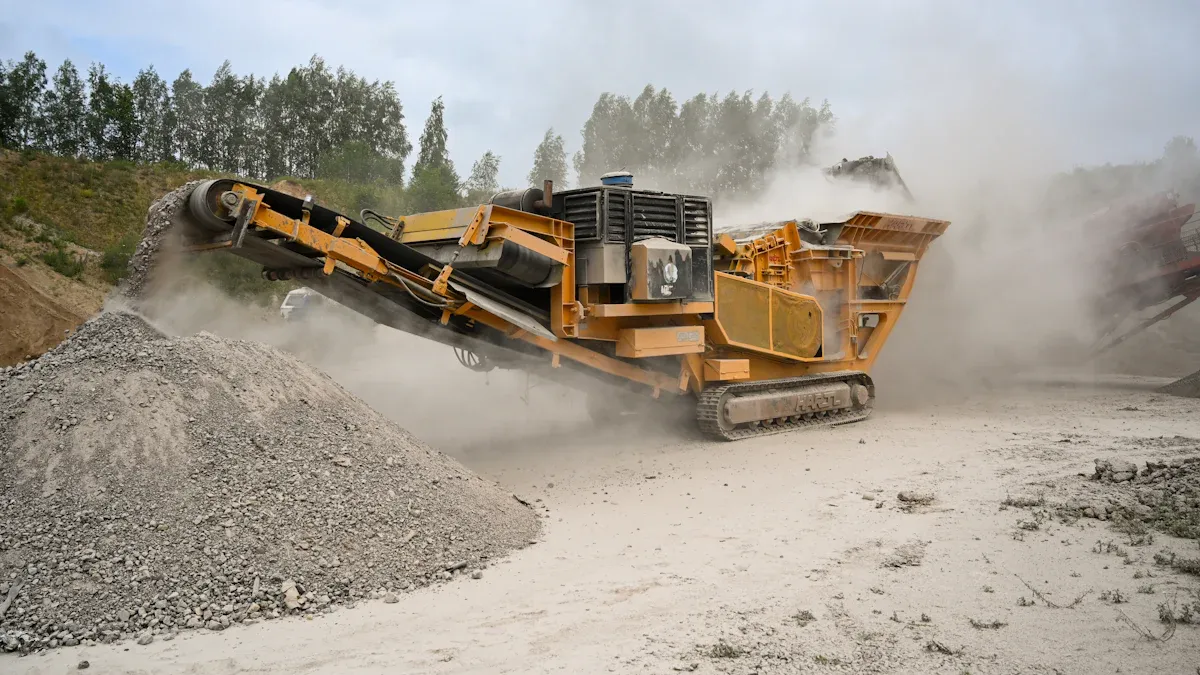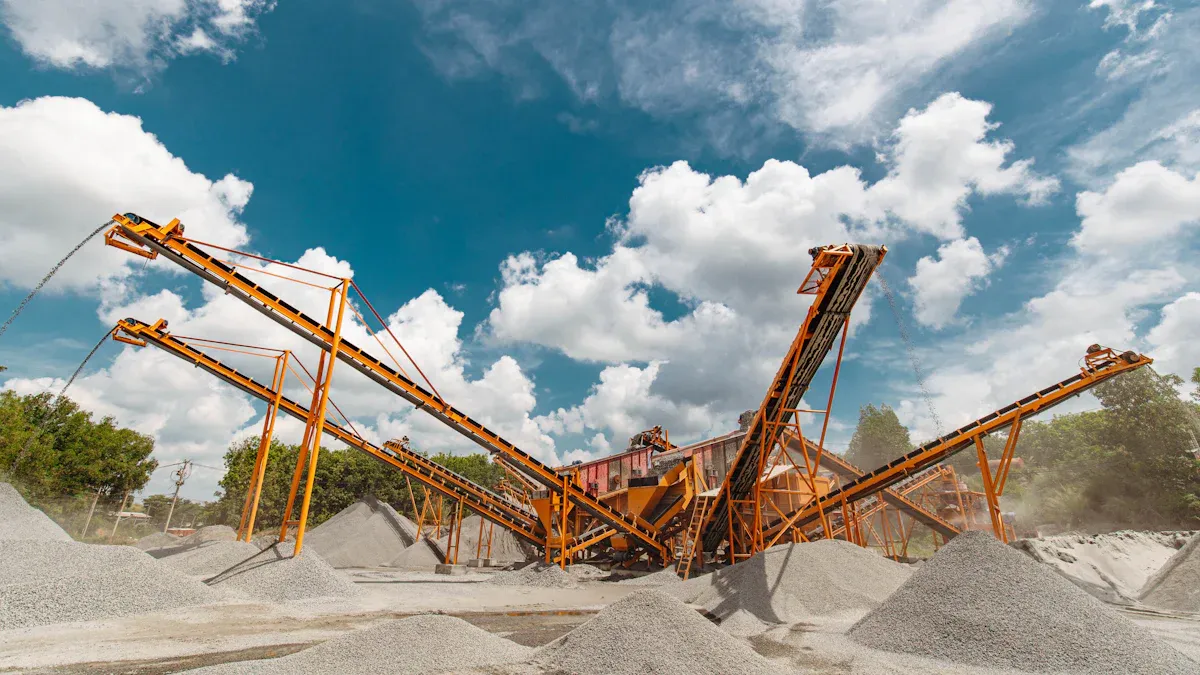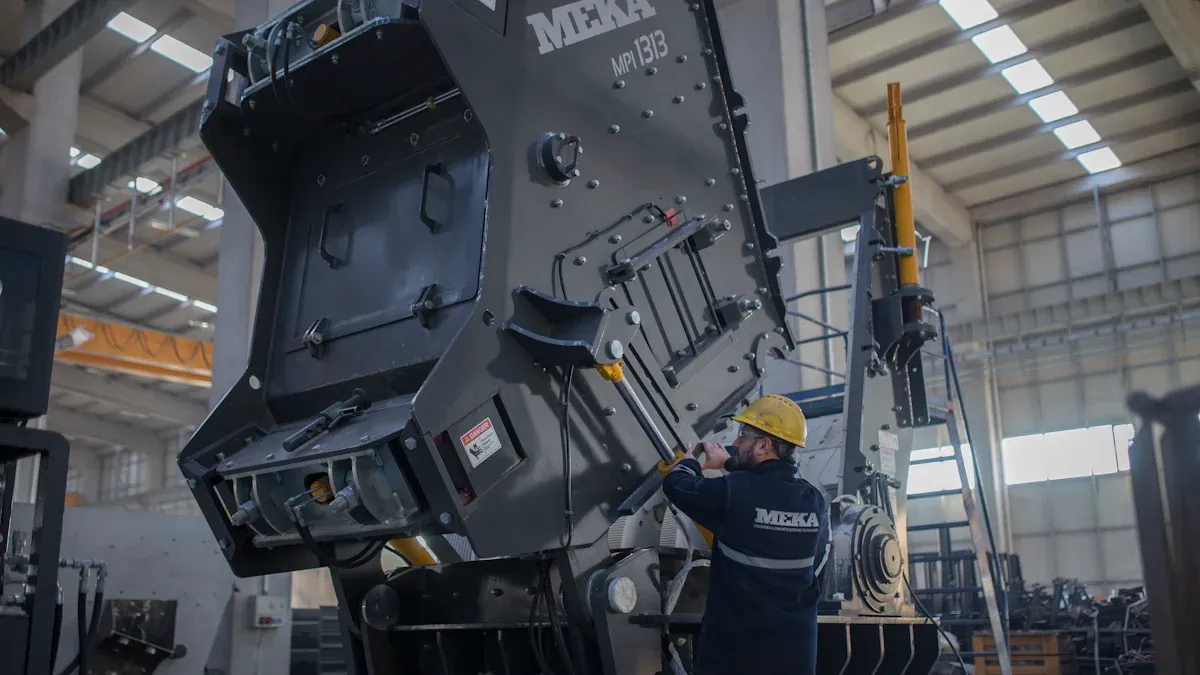
Proper installation of jaw crusher cheek plates is essential for achieving optimal performance. When you install these plates correctly, they protect your machine from wear and ensure smooth operation. This not only extends the lifespan of your equipment but also boosts its efficiency.
Ignoring proper installation can lead to misalignments, reduced performance, or even costly damage. By taking the time to install the cheek plates accurately, you minimize risks and maximize results.
Jaw crusher cheek plates are critical components in the crushing process. These plates hold the rock in place as the machine crushes it into smaller pieces. By keeping the material steady, they ensure that the crusher operates efficiently and produces the desired output size. Without cheek plates, the crushing process would lack precision, leading to inconsistent results.
Cheek plates play a vital role in safeguarding the jaw crusher from damage. They shield the sides of the crusher frame from wear caused by constant contact with abrasive materials. This protection extends the lifespan of the machine and reduces the need for frequent repairs. Additionally, cheek plates provide extra wear resistance for the mainframe, ensuring that the crusher remains in good working condition for longer periods.
They protect the sides of the jaw crusher frame from wear and damage.
They add an extra layer of protection to the mainframe, reducing maintenance costs.
The materials used in jaw crusher cheek plates significantly impact the machine's efficiency. High-quality materials, such as wear-resistant steel or lightweight composites, enhance durability while simplifying maintenance. This balance ensures that the crusher operates smoothly and consistently. By reducing wear and tear, cheek plates also help maintain the crusher's performance over time, allowing you to achieve optimal results with minimal downtime.
Tip: Regularly inspect and replace worn cheek plates to keep your jaw crusher running at peak efficiency.

Before installing jaw crusher cheek plates, you must prepare the machine and the site to ensure a smooth process. Follow these steps to get started:
Site Assessment: Check the terrain where the crusher will operate. Make sure the ground is stable and level to prevent unnecessary vibrations or movement.
Equipment Selection: Confirm that the jaw crusher is suitable for the material you plan to process. This ensures efficient crushing and reduces wear on the cheek plates.
Initial Preparation: Gather all necessary tools, such as wrenches, bolts, and safety gear. Verify that safety protocols are in place to protect workers during the installation.
Positioning: Place the crusher on stable ground. Secure it firmly to prevent shifting during operation.
Utility Connections: Inspect and connect the electrical and hydraulic systems. Ensure all connections are tight and functional.
Calibration and Testing: Perform a test run to confirm that the crusher is functioning correctly before proceeding with the installation.
Tip: Use jack screws and spirit levels to ensure the crusher is perfectly level. This step is crucial for proper alignment of the cheek plates.
Removing the old or damaged cheek plates is the next step. This process requires careful handling to avoid damaging the jaw crusher. Here's how you can do it:
Turn Off the Machine: Disconnect the power supply and ensure the crusher is completely shut down. This eliminates the risk of accidental operation.
Loosen the Bolts: Use the appropriate tools to loosen the bolts securing the cheek plates. Work systematically to avoid uneven pressure on the frame.
Remove the Plates: Carefully lift the old cheek plates out of the crusher. If they are stuck due to wear or debris, use a pry bar to dislodge them gently.
Inspect the Frame: Check the jaw crusher frame for any signs of wear or damage. Clean the surface to remove dirt, grease, or leftover material.
Note: Always wear protective gloves and goggles during this step to safeguard against sharp edges or flying debris.
Once the old plates are removed, you can install the new jaw crusher cheek plates. Proper installation ensures optimal performance and durability. Follow these steps:
Align the Plates: Position the new cheek plates carefully against the crusher frame. Ensure they align perfectly with the mounting holes.
Secure with Bolts: Insert the bolts and tighten them evenly. Use a torque wrench to apply the correct amount of pressure, as specified by the manufacturer.
Check for Gaps: Inspect the edges of the plates to ensure there are no gaps between the plates and the frame. Gaps can lead to misalignment and uneven wear.
Test the Fit: Gently move the jaw to confirm that the plates are securely in place and do not interfere with the crusher's operation.
Pro Tip: Apply a thin layer of lubricant to the bolts before tightening. This prevents rust and makes future maintenance easier.
Proper alignment and fit of jaw crusher cheek plates are critical for achieving optimal performance and preventing unnecessary wear. Misaligned plates can lead to uneven crushing, increased stress on the machine, and premature failure of components. Follow these steps to ensure correct alignment:
Inspect the Mounting Surface: Before placing the cheek plates, check the mounting surface for debris or irregularities. A clean and smooth surface ensures a snug fit.
Use Alignment Tools: Utilize tools like spirit levels or alignment gauges to position the plates accurately. These tools help you avoid misalignment that could affect the crusher's efficiency.
Tighten Bolts Evenly: Secure the plates by tightening the bolts in a crisscross pattern. This method distributes pressure evenly, preventing gaps or uneven stress on the plates.
Verify Plate Positioning: After securing the bolts, visually inspect the plates to confirm they are flush with the frame. Run a hand along the edges to feel for any protrusions or gaps.
Tip: Always refer to the manufacturer's guidelines for specific alignment instructions. These guidelines are tailored to your machine's design and ensure the best results.
Before operating the jaw crusher, conduct a thorough inspection to confirm that all components, including the cheek plates, are installed correctly and functioning as intended. A final inspection minimizes the risk of operational issues and ensures safety. Use the following checklist to guide your inspection:
| Inspection Frequency | Inspection Items |
|---|---|
| Daily | - Check jaw die and key/heel bolts are tight. |
| - Ensure the discharge area is free of buildup. | |
| - Inspect the toggle plate for cracks. | |
| - Listen for knocking sounds and check for unusual vibrations. | |
| - Lubricate the four bearings. | |
| Weekly | - Log motor amps and bearing temperatures. |
| - Inspect the feed hopper for loose bolts and cracks. | |
| - Check flywheels for material buildup. | |
| - Verify drive belt tension. |
In addition to the table above, consider these key points:
Monitor Amperage: Log the motor's amperage daily to detect changes. A sudden increase may indicate bearing problems or loose belts.
Inspect Cheek Plates: Check for excessive wear or improper fit. Misaligned plates can cause uneven crushing and reduce efficiency.
Clean Components: Remove debris from flywheels and other moving parts. Clean components operate more smoothly and last longer.
Pro Tip: Keep a maintenance log to track inspection results and identify patterns over time. This practice helps you schedule preventive maintenance and avoid costly repairs.
By completing these steps, you ensure that your jaw crusher cheek plates and other components are ready for operation. A well-maintained machine delivers consistent performance and reduces downtime.
Even small mistakes during installation can lead to significant problems for your jaw crusher. By understanding and avoiding these common errors, you can ensure the cheek plates perform as intended and extend the life of your equipment.
Using the wrong tools or materials during installation can compromise the performance of your jaw crusher. For example, using bolts that are not designed for high-stress environments may cause the cheek plates to loosen over time. Similarly, low-quality cheek plates made from substandard materials wear out quickly, leading to frequent replacements and increased downtime.
To avoid these issues:
- Choose high-quality cheek plates: Opt for materials like wear-resistant steel or composites recommended by the manufacturer.
- Use the right tools: Always use tools specified for the job, such as torque wrenches for precise bolt tightening.
- Inspect materials before use: Check for defects or damage in the cheek plates and bolts before installation.
Tip: Keep a dedicated set of tools for jaw crusher maintenance to avoid using inappropriate equipment.
Misaligned cheek plates can cause uneven wear, reduce crushing efficiency, and increase stress on the machine. This mistake often occurs when the plates are not properly aligned with the mounting surface or when bolts are tightened unevenly.
To prevent misalignment:
1. Clean the mounting surface: Remove debris and ensure the surface is smooth before placing the cheek plates.
2. Use alignment tools: Tools like spirit levels or alignment gauges help position the plates accurately.
3. Tighten bolts evenly: Follow a crisscross pattern to distribute pressure equally and avoid gaps.
DANGER! Never place yourself or other personnel in a position beneath or adjacent to a cheek plate that is not properly secured against unintended movement. A worker must never be in the crushing cavity while a cheek plate is being lifted out or lowered in.
DANGER! Before lifting the cheek plate, check the condition of the lifting hole in the plate. Lifting hole is acceptable when the lifting tool locks into the cheek plate and does not come loose in any position.
By taking these precautions, you ensure the cheek plates fit securely and function as intended.
Improperly tightened bolts can lead to serious issues, including loose cheek plates, misalignment, and even damage to the crusher frame. Over-tightening can strip the threads or crack the mounting surface, while under-tightening allows the plates to shift during operation.
To tighten bolts correctly:
- Follow the manufacturer's torque specifications: Use a torque wrench to apply the recommended pressure.
- Tighten in stages: Gradually tighten the bolts in a crisscross pattern to ensure even pressure.
- Inspect after tightening: Check for gaps or movement in the cheek plates after securing the bolts.
Pro Tip: Apply a small amount of anti-seize lubricant to the bolts before tightening. This prevents rust and makes future maintenance easier.
By avoiding these common mistakes, you can ensure a smooth installation process and maximize the performance of your jaw crusher. Proper installation not only improves efficiency but also reduces the risk of costly repairs and downtime.
Failing to follow manufacturer guidelines during the installation of jaw crusher cheek plates can lead to serious problems. These guidelines are designed to ensure the safety, efficiency, and longevity of your equipment. Ignoring them often results in improper installation, reduced performance, and costly repairs.
Every jaw crusher is unique. Manufacturers provide specific instructions tailored to the design and materials of their machines. These instructions include details about torque specifications, alignment procedures, and recommended tools. By following these guidelines, you ensure that the cheek plates fit perfectly and function as intended.
Tip: Always keep the manufacturer's manual handy during installation. It serves as a step-by-step guide to avoid mistakes.
When you overlook manufacturer recommendations, you expose your machine to unnecessary risks. Here are some common issues that arise:
Improper Torque Application: Tightening bolts without following the specified torque can lead to loose plates or damage to the frame.
Misalignment: Skipping alignment instructions causes uneven wear and reduces crushing efficiency.
Using Incorrect Materials: Substituting recommended cheek plates with cheaper alternatives often results in faster wear and frequent replacements.
Safety Hazards: Ignoring safety protocols increases the risk of accidents during installation or operation.
Warning: Using non-standard parts or tools voids most manufacturer warranties. This leaves you responsible for repair costs if something goes wrong.
To avoid these pitfalls, make it a habit to review and follow the manufacturer's guidelines. Here’s how you can stay on track:
Read the Manual Thoroughly: Before starting the installation, read the manual from start to finish. Pay attention to torque values, alignment steps, and safety precautions.
Use Recommended Tools: Stick to the tools specified by the manufacturer. For example, use a torque wrench to apply the correct pressure when tightening bolts.
Follow Step-by-Step Instructions: Complete each step in the order outlined in the manual. Skipping steps often leads to errors.
Consult the Manufacturer: If you have questions or encounter issues, contact the manufacturer for guidance. Most companies offer technical support to help you resolve problems.
Pro Tip: Keep a digital copy of the manual on your phone or tablet for quick reference during installation.
By adhering to manufacturer guidelines, you protect your investment and ensure your jaw crusher operates at peak performance. This simple step saves you time, money, and frustration in the long run.

Inspecting your jaw crusher cheek plates regularly helps you identify wear and damage early. This practice ensures the plates perform efficiently and prevents costly repairs. Look for visible signs of wear, such as thinning or cracks. Pay attention to uneven surfaces, as they can indicate misalignment or improper installation.
Create a routine inspection schedule. For example, check the plates daily during heavy usage or wee kly for lighter operations. Use a flashlight to examine hard-to-see areas. If you notice excessive wear, plan for a replacement immediately to avoid further damage to the crusher.
Tip: Keep a log of your inspections. This record helps you track wear patterns and predict when replacements are needed.
Keeping the cheek plates clean and well-lubricated ensures smooth operation. Dirt and debris can accumulate on the plates, reducing their efficiency and causing uneven wear. Use a soft brush or compressed air to remove debris after each use. Avoid using harsh chemicals that could damage the material.
Lubrication is equally important. Apply a thin layer of lubricant to the bolts and mounting surfaces during maintenance. This prevents rust and makes future adjustments easier. Always use lubricants recommended by the manufacturer for the best results.
Pro Tip: Clean and lubricate the plates after every 40 hours of operation to maintain peak performance.
Replacing worn jaw crusher cheek plates on time prevents further damage to your machine. Worn plates reduce crushing efficiency and increase stress on other components. Monitor the thickness of the plates during inspections. If they fall below the manufacturer’s recommended limit, replace them immediately.
When replacing the plates, follow the installation steps carefully. Ensure proper alignment and tighten the bolts to the specified torque. This guarantees the new plates fit securely and function as intended.
Warning: Operating the crusher with severely worn plates can lead to equipment failure and safety hazards. Always prioritize timely replacements.
Monitoring the performance of your jaw crusher cheek plates is essential for identifying potential issues before they escalate. Early detection helps you maintain efficiency, reduce downtime, and avoid costly repairs. By keeping a close eye on key performance indicators, you can ensure your equipment operates at its best.
Crushing Efficiency: Pay attention to the crusher's output. A sudden drop in production may indicate worn cheek plates or alignment problems.
Wear Patterns: Inspect the cheek plates for uneven wear. This could signal misalignment or improper installation.
Noise Levels: Listen for unusual sounds during operation. Grinding or knocking noises often point to loose plates or damaged components.
Vibration: Excessive vibration can indicate misaligned plates or issues with the crusher's frame.
Tip: Use a vibration monitoring device to track changes over time. This tool helps you spot problems early.
Daily Checks: Perform quick visual inspections and listen for unusual sounds.
Weekly Logs: Record data such as motor amperage, output levels, and wear measurements.
Advanced Tools: Use sensors or monitoring systems to track performance metrics in real-time.
Pro Tip: Compare current performance data with historical records. This practice helps you identify trends and predict when maintenance is needed.
By monitoring these factors, you can catch small issues before they become major problems. Regular performance checks not only extend the life of your cheek plates but also improve the overall efficiency of your jaw crusher.
Jaw crusher cheek plates play a vital role in protecting your machine and ensuring efficient crushing. Proper installation involves careful preparation, alignment, and bolt tightening, while regular maintenance keeps the plates in top condition.
Remember: Inspect cheek plates frequently, clean them after use, and replace them when worn.
By following these steps, you enhance your crusher's performance, reduce downtime, and save on repair costs. A well-maintained jaw crusher not only lasts longer but also delivers consistent results, making it a valuable asset for your operations.
You need a torque wrench, alignment tools (like spirit levels), and safety gear. A pry bar may help remove old plates. Always use tools recommended by the manufacturer for the best results.
Tip: Keep a dedicated toolbox for crusher maintenance to avoid using incorrect tools.
Inspect cheek plates daily during heavy use or weekly for lighter operations. Look for thinning, cracks, or uneven surfaces. Regular inspections help you catch issues early and prevent costly repairs.
Pro Tip: Use a flashlight to examine hard-to-see areas for wear.
No, you should not reuse bolts. Old bolts may weaken over time, compromising the cheek plates' stability. Always replace bolts with new ones that meet the manufacturer's specifications.
Warning: Reusing bolts increases the risk of loose plates and operational hazards.
Misaligned cheek plates cause uneven wear, reduce crushing efficiency, and increase stress on the machine. This can lead to premature failure of components and costly repairs.
Reminder: Use alignment tools to position plates accurately and tighten bolts evenly.
Replace cheek plates when they fall below the manufacturer’s recommended thickness or show visible damage. Operating with worn plates reduces efficiency and risks damaging the crusher.
Emoji Tip: 🛠️ Regular checks = Longer machine life!